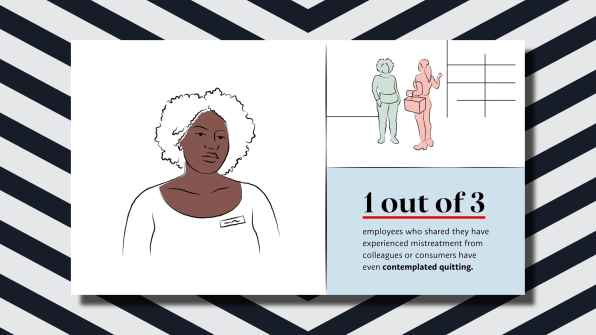Sephora has been accused of racially profiling buyers of colour, trailing them with shop law enforcement and suspecting them of stealing. This 7 days, the enterprise is making an attempt to give itself a makeover.
Sephora done a yearlong study measuring systemic racism in U.S. retail environments. Centered on its conclusions, it has announced a raft of measures to deal with discrimination experienced by equally customers and staff. The action prepare involves lowering third-celebration safety in shops, doubling the selection of Black-owned brands that it carries, and developing a zero-tolerance coverage when personnel discriminate.
Will these new guidelines truly do the job? That is an open up query, specially due to the fact Sephora made available couple details about how it intends to implement the improvements. “The insurance policies are fairly vague,” says Frank Dobbin, a professor of sociology at Harvard College who reports corporate range applications. “And research have proven that zero-tolerance policies generally backfire.”
Sephora’s research
In tumble 2019, right after R&B singer SZA reported she’d been racially profiled in a Sephora store, the corporation commissioned a research to superior comprehend how Black, Indigenous, and folks of colour (BIPOC) expertise American retail—both within just its individual stores and at other brand names. This 7 days, Sephora publicly shared its findings, which paint a picture of constant discrimination toward Black and brown clients and personnel.

Black shoppers are two and a half situations more most likely than white purchasers to practical experience unfair remedy dependent on the colour of their skin. Employees of shade also struggle—20% report acquiring knowledgeable unfair cure based on their race from buyers or coworkers, and 37% of Black staff members have contemplated quitting as a end result.
Sephora discovered some overarching truths about shoppers’ experiences with racial bias. For occasion, there is a disconnect concerning how consumers and workforce interpret interactions in outlets. BIPOC prospects imagine in-shop interactions are driven by their skin colour and ethnicity staff imagine these interactions are driven by actions relatively than appearance. This indicates there may be implicit bias at work, whereby workers unconsciously stereotype shoppers.
Holes in the action plan
Sephora’s motion plan tries to deal with this with unconscious bias training. There’s only one particular challenge, states Dobbin. “There have been more than a thousand research that display you can not train away bias,” he claims. “Bias is dependent on stereotypes that are created above a lifetime from items like observing television and experiencing poverty on a road.”
Dobbins is also concerned about the new zero-tolerance policy, which suggests that personnel will be fired if they are shown to engage in discriminatory behavior. Dobbins suggests these policies can discourage workforce from bringing issues when they practical experience or witness harassment simply because they’re concerned they may possibly get backlash for obtaining another person fired. “Already, a vanishingly little share of individuals who practical experience harassment at operate truly complain,” he suggests. “With a zero-tolerance plan, employees worry that the retaliation towards them will be a great deal harsher.”
When I attained out to Sephora about this coverage, a spokesperson stated this was just one aspect of the over-all prepare. “We figure out that no one motion will push the improve we purpose to attain on its have,” I was informed via e mail. “The factors of our action system are created to function jointly to drive optimistic improve across our firm.”
Sephora intends to make use of other, a lot more explicit techniques of encouraging Black and brown clients experience welcome in its suppliers, such as rolling out a new greeting program that will be used to just about every shopper continually. The organization also says there will be fewer 3rd-celebration safety guards in suppliers, replaced by “in-house specialists.” Dobbins isn’t sure this will have the intended result. “What this implies is that they’re going to have their possess safety people today, and educate them not to racially profile,” he suggests. “I’m not positive that is going to function, provided that you just can’t train absent bias.”
A spokesperson explained this would give the business extra control around how stability staff interact with buyers. “Our in-house experts will be embedded in Sephora’s lifestyle and anticipations,” the spokesperson reported. “They will acquire normal and ongoing education and education, and their overall performance will be assessed as we track development.”
What could function
Dobbins believes there are some aspects of Sephora’s approach that could be effective. While he claims bias schooling does not function, there’s evidence that appointing minorities to management roles does make improvements to the tradition of an corporation. Sephora declared a new recruiting, mentorship, and career enhancement plan to assist the advancement of staff of colour, while it did not give several particulars or metrics around this target. Still, Dobbins thinks that obtaining additional BIPOC employees, significantly in large positions, is a good phase.
That reported, Sephora could choose things a stage even more by supplying benefits that will keep these staff members, Dobbins argues. Right now, Sephora’s policies adhere closely to what personal states need, but Dobbins implies that featuring rewards such as maternity go away and baby care assist that go past what is needed could go a lengthy way toward retaining and advancing staff of color, who are most very likely to advantage from this kind of procedures.
“The attractiveness industry is dominated by females, and one particular of the most successful methods of escalating race and ethnic range of the woman workforce is like extra do the job-lifetime courses that boost versatility,” he suggests. “This would be number one on my checklist.”
Around the summer time, Sephora signed the 15% pledge, committing to stocking 15% of its shelves with Black-owned makes. The company suggests it is actively doing work toward this intention, and as section of it aims to double the number of Black-owned models it carries by the finish of the yr.
In its announcement, Sephora helps make clear that this is just a “preliminary” motion system, subject matter to improve and improvement. And the firm has promised to publicly report its development 2 times a yr. We’ll be observing to see how these new guidelines play out.




















